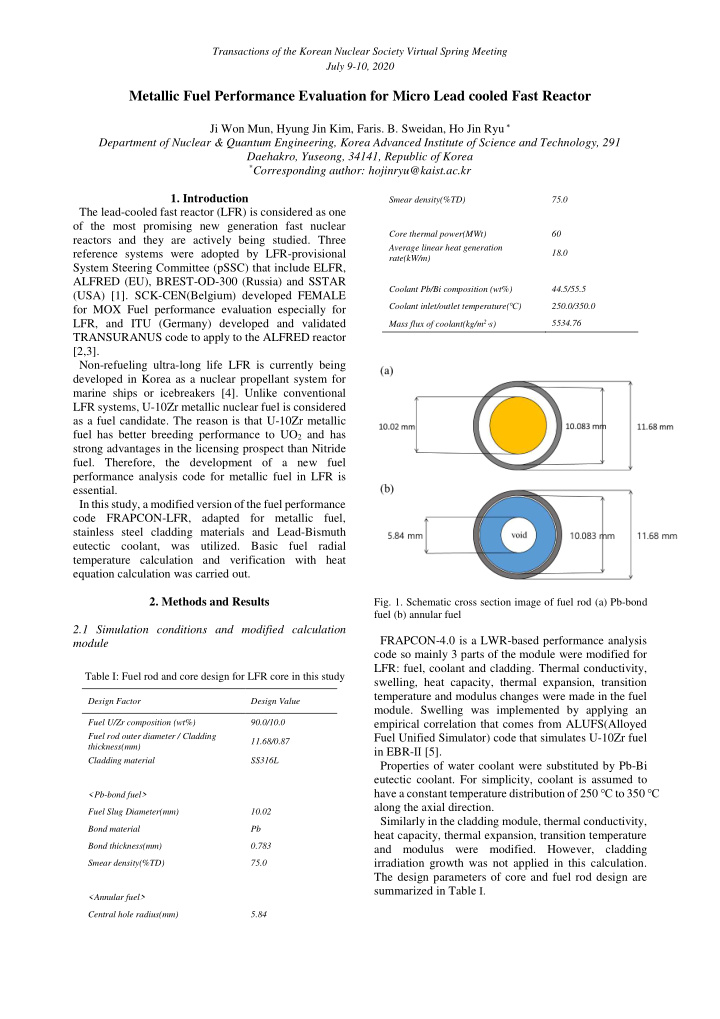



Transactions of the Korean Nuclear Society Virtual Spring Meeting July 9-10, 2020 Metallic Fuel Performance Evaluation for Micro Lead cooled Fast Reactor Ji Won Mun, Hyung Jin Kim, Faris. B. Sweidan, Ho Jin Ryu Department of Nuclear & Quantum Engineering, Korea Advanced Institute of Science and Technology, 291 Daehakro, Yuseong, 34141, Republic of Korea * Corresponding author: hojinryu@kaist.ac.kr 1. Introduction Smear density(%TD) 75.0 The lead-cooled fast reactor (LFR) is considered as one of the most promising new generation fast nuclear Core thermal power(MWt) 60 reactors and they are actively being studied. Three Average linear heat generation reference systems were adopted by LFR-provisional 18.0 rate(kW/m) System Steering Committee (pSSC) that include ELFR, ALFRED (EU), BREST-OD-300 (Russia) and SSTAR Coolant Pb/Bi composition (wt%) 44.5/55.5 (USA) [1]. SCK-CEN(Belgium) developed FEMALE Coolant inlet/outlet temperature( ℃ ) 250.0/350.0 for MOX Fuel performance evaluation especially for Mass flux of coolant(kg/m 2 ∙ s) LFR, and ITU (Germany) developed and validated 5534.76 TRANSURANUS code to apply to the ALFRED reactor [2,3]. Non-refueling ultra-long life LFR is currently being developed in Korea as a nuclear propellant system for marine ships or icebreakers [4]. Unlike conventional LFR systems, U-10Zr metallic nuclear fuel is considered as a fuel candidate. The reason is that U-10Zr metallic fuel has better breeding performance to UO 2 and has strong advantages in the licensing prospect than Nitride fuel. Therefore, the development of a new fuel performance analysis code for metallic fuel in LFR is essential. In this study, a modified version of the fuel performance code FRAPCON-LFR, adapted for metallic fuel, stainless steel cladding materials and Lead-Bismuth eutectic coolant, was utilized. Basic fuel radial temperature calculation and verification with heat equation calculation was carried out. 2. Methods and Results Fig. 1. Schematic cross section image of fuel rod (a) Pb-bond fuel (b) annular fuel 2.1 Simulation conditions and modified calculation FRAPCON-4.0 is a LWR-based performance analysis module code so mainly 3 parts of the module were modified for LFR: fuel, coolant and cladding. Thermal conductivity, Table I: Fuel rod and core design for LFR core in this study swelling, heat capacity, thermal expansion, transition temperature and modulus changes were made in the fuel Design Factor Design Value module. Swelling was implemented by applying an Fuel U/Zr composition (wt%) 90.0/10.0 empirical correlation that comes from ALUFS(Alloyed Fuel rod outer diameter / Cladding Fuel Unified Simulator) code that simulates U-10Zr fuel 11.68/0.87 thickness(mm) in EBR- Ⅱ [5]. Cladding material SS316L Properties of water coolant were substituted by Pb-Bi eutectic coolant. For simplicity, coolant is assumed to have a constant temperature distribution of 250 ℃ to 350 ℃ <Pb-bond fuel> along the axial direction. Fuel Slug Diameter(mm) 10.02 Similarly in the cladding module, thermal conductivity, Bond material Pb heat capacity, thermal expansion, transition temperature Bond thickness(mm) 0.783 and modulus were modified. However, cladding irradiation growth was not applied in this calculation. Smear density(%TD) 75.0 The design parameters of core and fuel rod design are summarized in Table I. <Annular fuel> Central hole radius(mm) 5.84
Transactions of the Korean Nuclear Society Virtual Spring Meeting July 9-10, 2020 2.2 Fuel radial temperature with Helium gap In the case of metallic fuel, pellet-cladding mechanical interaction (PCMI) due to swelling is a major nuclear fuel failure mechanism, and the smeared density is low to about 75% to prevent this phenomenon. First, fuel temperature for metallic fuel with the helium gap case was calculated by FRAPCON-KAIST and validated by heat equation calculation. The fuel centerline temperature was calculated at about 2351 K and it leads to fuel melt at the first time step. No further calculations was made since then. Fig. 3. Radial temperature calculation results with lead bond Fig. 3 shows the radial temperature distribution when molten lead bonding was included. In both FRAPCON- LFR and calculation cases, the bulk coolant temperature was similar at about 573K. It was shown that the calculation results were almost identical except for the error when transferred from the coolant to cladding. However in lead bonded fuel, high temperature corrosion of cladding by lead should be considered. Also, Fig. 4 shows that lead bond can be limited due to the formation of intermetallics PbU [7]. Fig. 2. Radial temperature calculation results by hand calculation with the helium gap Hand calculation was conducted to cross-check the results of FRAPCON-KAIST and Fig. 2 shows that the fuel centerline temperature, similar to the previous results, is calculated to be around 2300 K. Therefore, without any bonding materials between fuel slug and cladding, a meltdown of nuclear fuel is expected. 2.3 Fuel radial temperature with Pb bond In section 2.2, it is obvious that thermal bonding material is needed to compensate for the reduction in thermal conductivity due to wide gaps. Usually, Na bonding is utilized for metallic fuels in Sodium cooled Fast Reactor (SFR). However, in the situation where the Fig. 4. Phase diagram of U-Pb system [8] fuel-coolant interaction occurs, Na bonding and Bi in the coolant can interact. In this case, the Na- Bi reaction is 2.4 Annular fuel radial temperature distribution exothermic so there are possibilities of local heating. Also, when the sodium is included inside the LBE, solid Annular fuel or mechanically bonded fuel concept was intermetallics will form and small channel space between proposed for advanced fuel for liquid-metal cooled fast the cladding can block the flow of the coolant [6]. In this breeder reactor because it has not only lower axial sense, lead bonding was suggested in previous research swelling, but also very large improvements of the that utilizes metallic fuel in LFR core [7]. neutron economy of fast reactors than conventional nuclear fuel [9, 10]. Normally the fuel and cladding are mechanically bonded by Zr-liner at the inner wall of the cladding but the liner is not considered in this calculation.
Recommend
More recommend